The Role of Climate Change and Its Sensitivity on Long-Term Standardized Precipitation Evapotranspiration Index, Vegetation and Drought Changing Trends over East Asia
Abstract
:1. Introduction
2. Results and Discussion
2.1. Drought Analysis of SPEI
2.2. Temporal Annual Average SPEI Trends across East Asia
2.3. Drought Frequency (DF)
2.4. Drought Duration (DD)
2.5. Drought Intensity (DI)
2.6. Seasonal Average SR, WVP, WS, VCI, TCI, and VHI Distribution Values
2.7. Stage Characteristics of Seasonal Temporal SPEI in Sub-Regions of East Asia
3. Study Region and Data Analysis
3.1. Study Area
3.2. Datasets
3.3. Standardized Precipitation Evapotranspiration Index (SPEI)
3.4. Drought Characterization
3.5. Drought Frequency (DF)
3.6. Drought Duration (DD)
3.7. Drought Intensity (DI)
3.8. Vegetation Condition Index (VCI)
3.9. Temperature Condition Index (TCI)
3.10. Vegetation Health Index (VHI)
4. Conclusions
Author Contributions
Funding
Data Availability Statement
Acknowledgments
Conflicts of Interest
References
- Milly, P.C.D.; Dunne, K.A. Potential evapotranspiration and continental drying. Nat. Clim. Chang. 2016, 6, 946–949. [Google Scholar] [CrossRef]
- Van Der Schrier, G.; Jones, P.D.; Briffa, K.R. The sensitivity of the PDSI to the Thornthwaite and Penman-Monteith parameterizations for potential evapotranspiration. J. Geophys. Res. Atmos. 2011, 116, 1–16. [Google Scholar] [CrossRef]
- Shahzaman, M.; Zhu, W.; Bilal, M.; Habtemicheal, B.; Mustafa, F.; Arshad, M.; Ullah, I.; Ishfaq, S.; Iqbal, R. Remote Sensing Indices for Spatial Monitoring of Agricultural Drought in South Asian Countries. Remote Sens. 2021, 13, 2059. [Google Scholar] [CrossRef]
- IPCC. Summary for Policymakers. In Climate Change. The Physical Science Basis. Contribution of Working Group I to the Fifth Assessment Report of the Intergovernmental Panel on Climate Change; Cambridge University Press: Cambridge, UK, 2013; Available online: https://www.ipcc.ch/site/assets/uploads/2018/02/WG1AR5_SPM_FINAL.pdf (accessed on 1 November 2020).
- Wu, J.; Chen, X.; Yao, H.; Gao, L.; Chen, Y.; Liu, M. Non-linear relationship of hydrological drought responding to meteorological drought and impact of a large reservoir. J. Hydrol. 2017, 551, 495–507. [Google Scholar] [CrossRef]
- Gao, X.; Zhao, Q.; Zhao, X.; Wu, P.; Pan, W.; Gao, X.; Sun, M. Temporal and spatial evolution of the standardized precipitation evapotranspiration index (SPEI) in the Loess Plateau under climate change from 2001 to 2050. Sci. Total Environ. 2017, 595, 191–200. [Google Scholar] [CrossRef]
- Jones, P.D.D.; Moberg, A. Hemispheric and large-scale surface air temperature variations: An extensive revision and an update to 2001. J. Clim. 2003, 16, 206–223. [Google Scholar] [CrossRef]
- Nam, W.H.; Choi, J.Y.; Yoo, S.H.; Jang, M.W. A decision support system for agricultural drought management using risk assessment. Paddy Water Environ. 2012, 10, 197–207. [Google Scholar] [CrossRef]
- Ahmed, K.; Shahid, S.; Chung, E.S.; Nawaz, N.; Khan, N.; Rasheed, B. Divergence of potential evapotranspiration trends over Pakistan during 1967–2016. Theor. Appl. Climatol. 2020, 141, 215–227. [Google Scholar] [CrossRef]
- Redmond, K.T. The Depiction of Drought: A Commentary. Bull. Am. Meteorol. Soc. 2002, 83, 1143–1147. [Google Scholar] [CrossRef]
- Ault, T.R. On the essentials of drought in a changing climate. Science 2020, 368, 256–260. [Google Scholar] [CrossRef] [PubMed]
- Liu, L.; Gudmundsson, L.; Hauser, M.; Qin, D.; Li, S.; Seneviratne, S. Soil moisture dominates dryness stress on ecosystem production globally. Nat. Commun. 2020, 11, 4892. [Google Scholar] [CrossRef] [PubMed]
- Ma, Z.; Yan, N.; Wu, B.; Stein, A.; Zhu, W.; Zeng, H. Variation in actual evapotranspiration following changes in climate and vegetation cover during an ecological restoration period (2000–2015) in the Loess Plateau China. Sci. Total Environ. 2019, 689, 534–545. [Google Scholar] [CrossRef]
- Wang, Z.; Zhan, C.; Ning, L.; Guo, H. Evaluation of global terrestrial evapotranspiration in CMIP6 models. Theor. Appl. Climatol. 2021, 143, 521–531. [Google Scholar] [CrossRef]
- Naumann, G.; Alfieri, L.; Wyser, K.; Mentaschi, L.; Betts, R.A.; Carrao, H.; Spinoni, J.; Vogt, J.; Feyen, L. Global Changes in Drought Conditions under Different Levels of Warming. Geophys. Res. Lett. 2018, 45, 3285–3296. [Google Scholar] [CrossRef]
- Mirabbasi, R.; Fakheri-Fard, A.; Dinpashoh, Y. Bivariate drought frequency analysis using the copula method. Theor. Appl. Climatol. 2012, 108, 191–206. [Google Scholar] [CrossRef]
- Zhai, J.; Su, B.; Krysanova, V.; Vetter, T.; Gao, C.; Jiang, T. Spatial variation and trends in PDSI and SPI indices and their relation to Streamflow in 10 large regions of China. J. Clim. 2010, 23, 649–663. [Google Scholar] [CrossRef]
- Rajsekhar, D.; Singh, V.P.; Mishra, A.K. Multivariate drought index: An information theory based approach for integrated drought assessment. J. Hydrol. 2015, 526, 164–182. [Google Scholar] [CrossRef]
- United Nations Children’s Fund (UNICEF). Annual Report 2016; UNICEF: New York, NY, USA, 2017; pp. 1–82. [Google Scholar]
- Dai, A. Drought under global warming: A review. Wiley Interdiscipl. Rev. Clim. Chang. 2011, 2, 45–65. [Google Scholar] [CrossRef]
- Vicente, S.M.; Beguería, S.; Lópezmoreno, J.I.; Angulo, M.; Kenawy, A.E. A new global 0.58 gridded dataset (1901–2006) of a multiscalar drought index: Comparison with current drought index datasets based on the Palmer drought severity index. J. Hydrometeor. 2010, 11, 1033–1043. [Google Scholar] [CrossRef]
- Stahle, D.W. Anthropogenic mega drought. Science 2020, 68, 238–239. [Google Scholar] [CrossRef] [PubMed]
- Trenberth, K.E.; Dai, A.; Van Der Schrier, G.; Jones, P.D.; Barichivich, J.; Briffa, K.R.; Sheffield, J. Global warming and changes in drought. Nat. Clim. Chang. 2013, 4, 17–22. [Google Scholar] [CrossRef]
- Tierney, J.E.; Ummenhofer, C.C.; deMenocal, P.B. Past and future rainfall in the Horn of Africa. Sci. Adv. 2015, 1, e1500682. [Google Scholar] [CrossRef] [PubMed]
- Adhyani, N.L.; June, T.; Sopaheluwakan, A. Exposure to drought: Duration, severity and intensity (java, Bali and Nusa Tenggara). IOP Conf. Ser. Earth Environ. Sci. 2017, 58, 012040. [Google Scholar] [CrossRef]
- Koukouli, P.; Georgiou, P.E.; Karpouzos, D.K. Evaluation of climate change impacts on reference evapotranspiration under RCPs scenarios in northern Greece. Glob. Nest J. 2019, 21, 519–529. [Google Scholar] [CrossRef]
- Lian, Y.; Qian, G.; Zhi, G.; Hong, J.; Laurent, L. Bias correction and projection of surface air temperature in LMDZ multiple simulation over central and eastern China. Adv. Clim. Chang. Res. 2018, 9, 81–92. [Google Scholar] [CrossRef]
- Bai, P.; Liu, X.; Zhang, Y.; Liu, C. Assessing the Impacts of Vegetation Greenness Change on Evapotranspiration and Water Yield in China. Water Resour. Res. 2020, 56, e2019WR027019. [Google Scholar] [CrossRef]
- Kogan, F.N. Remote sensing of weather impacts on vegetation in nonhomogeneous areas. Int. J. Rem. Sens. 1990, 11, 1405–1419. [Google Scholar] [CrossRef]
- Yang, Y.; Gan, T.Y.; Tan, X. Spatiotemporal changes of drought characteristics and their dynamic drivers in Canada. Atmos. Res. 2020, 232, 104695. [Google Scholar] [CrossRef]
- Yin, D.; Roderick, M.L.; Leech, G.; Sun, F.; Huang, Y. The contribution of reduction in evaporative cooling to higher surface air temperatures during drought. Geophys. Res. Lett. 2014, 41, 7891–7897. [Google Scholar] [CrossRef]
- Wang, F.; Wang, Z.; Yang, H.; Zhao, Y. Study of the temporal and spatial patterns of drought in the Yellow River basin based on SPEI. Sci. China Earth Sci. 2018, 61, 1098–1111. [Google Scholar] [CrossRef]
- Pathak, A.A.; Dodamani, B.M. Comparison of meteorological drought indices for different climatic regions of an Indian river basin, Asia-Pacific Journal of atmospheric sciences. Asia-Pacif. J. Atmos. Sci. 2019, 56, 563–576. [Google Scholar] [CrossRef]
- Li, H.; Li, Y.; Huang, G.; Sun, J. Probabilistic assessment of crop yield loss to drought time-scales in Xinjiang. Int. J. Climatol. 2021, 41, 4077–4094. [Google Scholar] [CrossRef]
- Begueria, S.; Vicente-Serrano, S.M.; Reig, F.; Latorre, B. Standardized precipitation evapotranspiration index (spei) revisited: Parameter fitting, evapotranspiration models, tools, datasets and drought monitoring. Int. J. Climatol. 2014, 34, 3001–3023. [Google Scholar] [CrossRef]
- Song, S.; Bai, J. Increasing winter precipitation over arid central Asia under global warming. Atmosphere 2016, 7, 139. [Google Scholar] [CrossRef]
- Wang, Q.; Shi, P.; Lei, T.; Geng, G.; Liu, J.; Mo, X.; Li, X.; Zhou, H.; Wu, J. The alleviating trend of drought in the Huang-Huai-Hai Plain of China based on the daily SPEI. Int. J. Climatol. 2015, 35, 3760–3769. [Google Scholar] [CrossRef]
- Miao, C.Y.; Sun, Q.H.; Duan, Q.Y.; Wang, Y.F. Joint analysis of changes in temperature and precipitation on the Loess Plateau during the period 1961–2011. Clim. Dyn. 2016, 47, 3221–3234. [Google Scholar] [CrossRef]
- Lee, S.; Yoo, S.; Choi, J.; Bae, S. Assessment of the impact of climate change on drought characteristics in the Hwanghae plain, North Korea using time series SPI and SPEI: 1981–2100. Water 2017, 9, 579. [Google Scholar] [CrossRef]
- Su, B.; Huang, J.; Fischer, T.; Wang, Y.; Kundzewicz, Z.W.; Zhai, J.; Sun, H.; Wang, A.; Zeng, X.; Wang, G.; et al. Drought losses in China might double between the 1.5 °C and 2.0 °C warming. Proc. Natl. Acad. Sci. USA 2018, 115, 10600–10605. [Google Scholar] [CrossRef]
- Qi, G.; Bai, H.; Zhao, T.; Meng, Q.; Zhang, S. Sensitivity and areal differentiation of vegetation responses to hydrothermal dynamics on the northern and southern slopes of the Qinling Mountains in Shaanxi province. J. Geogr. Sci. 2021, 31, 785–801. [Google Scholar] [CrossRef]
- Gupta, V.; Jain, M.K. Investigation of multi-model spatiotemporal mesoscale drought projections over India under climate change scenario. J. Hydrol. 2018, 567, 489–509. [Google Scholar] [CrossRef]
- Hao, Z.; Singh, V.P. Entropy-based method for bivariate drought analysis. J. Hydrol. Eng. 2013, 18, 780–786. [Google Scholar] [CrossRef]
- Zhou, J.; Jiang, T.; Wang, Y.; Su, B.; Tao, H.; Qin, J.; Zhai, J. Spatiotemporal variations of aridity index over the Belt and Road region under the 1.5 °C and 2.0 °C warming scenarios. J. Geogr. Sci. 2020, 30, 37–52. [Google Scholar] [CrossRef]
- Haile, G.G.; Tang, Q.; Leng, G.; Jia, G.; Wang, J.; Cai, D.; Sun, S.; Baniya, B.; Zhang, Q. Long-term spatiotemporal variation of drought patterns over the Greater Horn of Africa. Sci. Total Environ. 2019, 704, 135299. [Google Scholar] [CrossRef]
- Tucker, C.J. Red and photographic infrared linear combinations for monitoring vegetation. Remote Sens. Environ. 1979, 8, 127–150. [Google Scholar] [CrossRef]
- Xu, L.; Chen, N.; Zhang, X. Global drought trends under 1.5 and 2 °C warming. Int. J. Climatol. 2019, 39, 2375–2385. [Google Scholar] [CrossRef]
- Asong, Z.E.; Wheater, H.S.; Bonsal, B.; Razavi, S.; Kurkute, S. Historical drought patterns over Canada and their relation to teleconnections. Hydrol. Earth Syst. Sci. 2018, 3, 54–67. [Google Scholar] [CrossRef]
- Wang, J.; Price, K.P.; Rich, P.M. Spatial patterns of NDVI in response to precipitation and temperature in the central Great Plains. Int. J. Remote Sens. 2001, 22, 3827–3844. [Google Scholar] [CrossRef]
- Spinoni, J.; Naumann, G.; Carrao, H.; Barbosa, P.; Vogt, J. World drought frequency, duration, and severity for 1951–2010. Int. J. Climatol. 2014, 34, 2792–2804. [Google Scholar] [CrossRef]
- Kogan, F.N. A typical pattern of vegetation conditions in southern Africa during El Nino years detected from AVHRR data using three-channel numerical index. Int. J Remote Sens. 1998, 19, 3688–3694. [Google Scholar] [CrossRef]
- Kogan, F.N.; Yang, B.; Wei, G.; Pei, Z.; Jiao, X. Modelling corn production in China using AVHRR-based vegetation health indices. Int. J. Remote Sens. 2005, 26, 2325–2336. [Google Scholar] [CrossRef]
- Liu, Q.; Zhang, S.; Zhang, H.; Bai, Y.; Zhang, J. Monitoring drought using composite drought indices based on remote sensing. Sci. Total Environ. 2020, 711, 134585. [Google Scholar] [CrossRef]
- Potopová, V.; Štěpánek, P.; Zahradníček, P.; Farda, A.; Türkott, L.; Soukup, J. Projected changes in the evolution of drought on various timescales over the Czech Republic according to Euro-CORDEX models. Int. J. Climatol. 2018, 38, e939–e954. [Google Scholar] [CrossRef]
- Praveen, B.; Talukdar, S.; Shahfahad Mahato, S.; Mondal, J.; Sharma, P.; Islam, A.R.M.T.; Rahman, A. Analyzing trend and forecasting of rainfall changes in India using non-parametrical and machine learning approaches. Sci. Rep. 2020, 10, 10342. [Google Scholar] [CrossRef]
- Mishra, V.; Bhatia, U.; Tiwari, A. Bias-corrected climate projections for South Asia from Coupled Model Intercomparison Project-6. Sci. Data 2020, 7, 338. [Google Scholar] [CrossRef]
- Shafiq, M.U.; Rasool, R.; Ahmed, P.; Dimri, A.P. Temperature and precipitation trends in Kashmir valley, north western Himalayas, Theoretical and applied climatology. Theor. Appl. Climatol. 2018, 135, 293–304. [Google Scholar] [CrossRef]
- Rhee, J.; Cho, J. Future changes in drought characteristics: Regional analysis for South Korea under CMIP5 projections. J. Hydrometeorol. 2016, 17, 437–451. [Google Scholar] [CrossRef]
- Mie Sein, Z.M.; Ullah, I.; Saleem, F.; Zhi, X.; Syed, S.; Azam, K. Interdecadal Variability in Myanmar Rainfall in the Monsoon Season (May–October) Using Eigen Methods. Water 2021, 13, 729. [Google Scholar] [CrossRef]
- Yadeta, D.; Kebede, A.; Tessema, N. Climate change posed agricultural drought and potential of rainy season for effective agricultural water management, Kesem sub-basin, Awash Basin, Ethiopia. Theor. Appl. Climatol. 2020, 140, 653–666. [Google Scholar] [CrossRef]
- Steinemann, A.; Iacobellis, S.F.; Cayan, D.R. Developing and evaluating drought indicators for decision-making. J. Hydrometeorol. 2015, 16, 1793–1803. [Google Scholar] [CrossRef]
- Lu, K.; Arshad, M.; Ma, X.; Ullah, I.; Wang, J.; Shao, W. Evaluating observed and future spatiotemporal changes in precipitation and temperature across China based on CMIP6-GCMs. Int. J. Climatol. 2022, 42, 7703–7729. [Google Scholar] [CrossRef]
- Jain, S.; Salunke, P.; Mishra, S.K.; Sahany, S.; Choudhary, N. Advantage of NEX-GDDP over CMIP5 and CORDEX Data: Indian Summer Monsoon. Atmos. Res. 2019, 228, 152–160. [Google Scholar] [CrossRef]
- Ali, S.; Tong, D.; Xu, Z.; Henchiri, M.; Wilson, K.; Siqi, S.; Zhang, J. Characterization of drought monitoring events through MODIS- and TRMM-based DSI and TVDI over South Asia during 2001–2017. Environ. Sci. Pollut. Res. 2019, 26, 33568–33581. [Google Scholar] [CrossRef]
- Shi, B.L.; Zhu, X.Y.; Hu, Y.C.; Yang, Y.Y. Spatial and temporal variations of drought in Henan Province over a 53-year period based on standardized precipitation evapotranspiration index. Geogr. Res. 2015, 34, 1547–1558. (In Chinese) [Google Scholar]
- Song, X.; Li, L.; Fu, G.; Li, J.; Zhang, A.; Liu, W.; Zhang, K. Spatial–temporal variations of spring drought based on spring-composite index values for the Songnen plain, Northeast China. Theor. Appl. Climatol. 2014, 116, 371–384. [Google Scholar] [CrossRef]
- Huang, J.; Xue, Y.; Sun, S.; Zhang, J. Spatial and temporal variability of drought during 1960–2012 in Inner Mongolia, North China. Quat. Int. 2015, 355, 134–144. [Google Scholar] [CrossRef]
- Zhou, L.; Wu, J.; Mo, X.; Zhou, H.; Diao, C. Quantitative and detailed spatiotemporal patterns of drought in China during 2001–2013. Sci. Total Environ. 2017, 589, 136–145. [Google Scholar] [CrossRef] [PubMed]
- Ali, S.; Basit, A.; Umair, M.; Ni, J. Impacts of climate and land coverage changes on potential evapotranspiration and its sensitivity on drought phenomena over South Asia. Inter. J. Climatol. 2024, 1–19. [Google Scholar] [CrossRef]
- Tian, H.; Pei, J.; Huang, J.; Li, X.; Wang, J.; Zhou, B.; Wang, L. Garlic and Winter Wheat Identification Based on Active and Passive Satellite Imagery and the Google Earth Engine in Northern China. Remote Sens. 2020, 12, 3539. [Google Scholar] [CrossRef]
- Wen, Z.; Wang, Q.; Ma, Y.; Jacinthe, P.A.; Liu, G.; Li, S.; Song, K. Remote estimates of suspended particulate matter in global lakes using machine learning models. Int. Soil Water Conserv. Res. 2024, 12, 200–216. [Google Scholar] [CrossRef]
- Lu, S.; Zhu, G.; Meng, G.; Lin, X.; Liu, Y.; Qiu, D.; Jiao, Y. Influence of atmospheric circulation on the stable isotope of precipitation in the monsoon margin region. Atmos. Res. 2024, 298, 107131. [Google Scholar] [CrossRef]
- Guan, H.; Huang, J.; Li, L.; Li, X.; Miao, S.; Su, W.; Huang, H. Improved Gaussian mixture model to map the flooded crops of VV and VH polarization data. Remote Sens. Environ. 2023, 295, 113714. [Google Scholar] [CrossRef]
- Huang, H.; Huang, J.; Wu, Y.; Zhuo, W.; Song, J.; Li, X.; Liang, S. The Improved Winter Wheat Yield Estimation by Assimilating GLASS LAI Into a Crop Growth Model With the Proposed Bayesian Posterior-Based Ensemble Kalman Filter. IEEE Trans. Geosci. Remote Sens. 2023, 61, 1–18. [Google Scholar] [CrossRef]
- Li, J.; Wang, Z.; Wu, X.; Xu, C.; Guo, S.; Chen, X. Toward Monitoring Short-Term Droughts Using a Novel Daily Scale, Standardized Antecedent Precipitation Evapotranspiration Index. J. Hydrometeorol. 2020, 21, 891–908. [Google Scholar] [CrossRef]
- Wu, X.; Guo, S.; Qian, S.; Wang, Z.; Lai, C.; Li, J.; Liu, P. Long-range precipitation forecast based on multipole and preceding fluctuations of sea surface temperature. Int. J. Climatol. 2022, 42, 8024–8039. [Google Scholar] [CrossRef]
- He, M.; Dong, J.; Jin, Z.; Liu, C.; Xiao, J.; Zhang, F.; Deng, L. Pedogenic processes in loess-paleosol sediments: Clues from Li isotopes of leachate in Luochuan loess. Geochim. Cosmochim. Acta 2021, 299, 151–162. [Google Scholar] [CrossRef]
- He, M.; Ren, T.; Jin, Z.D.; Deng, L.; Liu, H.; Cheng, Y.Y.; Chang, H. Precise analysis of potassium isotopic composition in plant materials by multi-collector inductively coupled plasma mass spectrometry. Spectrochim. Acta Part B At. Spectrosc. 2023, 209, 106781. [Google Scholar] [CrossRef]
- Wang, X.; Wang, T.; Xu, J.; Shen, Z.; Yang, Y.; Chen, A.; Piao, S. Enhanced habitat loss of the Himalayan endemic flora driven by warming-forced upslope tree expansion. Nat. Ecol. Evol. 2022, 6, 890–899. [Google Scholar] [CrossRef]
- Zhang, S.; Bai, X.; Zhao, C.; Tan, Q.; Luo, G.; Wang, J.; Xi, H. Global CO2 Consumption by Silicate Rock Chemical Weathering: Its Past and Future. Earth’s Future 2021, 9, e1938E–e2020E. [Google Scholar] [CrossRef]
- Cheng, Y.; Lan, S.; Fan, X.; Tjahjadi, T.; Jin, S.; Cao, L. A dual-branch weakly supervised learning based network for accurate mapping of woody vegetation from remote sensing images. Int. J. Appl. Earth Obs. Geoinf. 2023, 124, 103499. [Google Scholar] [CrossRef]
- Zheng, H.; Fan, X.; Bo, W.; Yang, X.; Tjahjadi, T.; Jin, S. A Multiscale Point-Supervised Network for Counting Maize Tassels in the Wild. Plant Phenomics 2023, 5, 100. [Google Scholar] [CrossRef]
- Xue, Y.; Bai, X.; Zhao, C.; Tan, Q.; Li, Y.; Luo, G.; Long, M. Spring photosynthetic phenology of Chinese vegetation in response to climate change and its impact on net primary productivity. Agric. For. Meteorol. 2023, 342, 109734. [Google Scholar] [CrossRef]
- Lin, X.; Zhu, G.; Qiu, D.; Ye, L.; Liu, Y.; Chen, L.; Sun, N. Stable precipitation isotope records of cold wave events in Eurasia. Atmos. Res. 2023, 296, 107070. [Google Scholar] [CrossRef]
- Zhu, W.; Chen, J.; Sun, Q.; Li, Z.; Tan, W.; Wei, Y. Reconstructing of High-Spatial-Resolution Three-Dimensional Electron Density by Ingesting SAR-Derived VTEC Into IRI Model. IEEE Geosci. Remote Sens. Lett. 2022, 19, 1–5. [Google Scholar] [CrossRef]
- Xu, J.; Zhou, G.; Su, S.; Cao, Q.; Tian, Z. The Development of A Rigorous Model for Bathymetric Mapping from Multispectral Satellite-Images. Remote Sens. 2022, 14, 2495. [Google Scholar] [CrossRef]
- Zhou, G.; Xu, C.; Zhang, H.; Zhou, X.; Zhao, D.; Wu, G.; Zhang, L. PMT gain self-adjustment system for high-accuracy echo signal detection. Int. J. Remote Sens. 2022, 43, 7213–7235. [Google Scholar] [CrossRef]
- Zhou, G.; Zhou, X.; Li, W.; Zhao, D.; Song, B.; Xu, C.; Zou, L. Development of a Lightweight Single-Band Bathymetric LiDAR. Remote Sens. 2022, 14, 5880. [Google Scholar] [CrossRef]
- Shang, K.; Xu, L.; Liu, X.; Yin, Z.; Liu, Z.; Li, X.; Zheng, W. Study of Urban Heat Island Effect in Hangzhou Metropolitan Area Based on SW-TES Algorithm and Image Dichotomous Model. SAGE Open 2023, 13, 21582440231208851. [Google Scholar] [CrossRef]
- Dong, W.; Zhao, J.; Qu, J.; Xiao, S.; Li, N.; Hou, S.; Li, Y. Abundance Matrix Correlation Analysis Network Based on Hierarchical Multihead Self-Cross-Hybrid Attention for Hyperspectral Change Detection. IEEE Trans. Geosci. Remote Sens. 2023, 61, 1–13. [Google Scholar] [CrossRef]
- Dong, W.; Yang, Y.; Qu, J.; Xiao, S.; Li, Y. Local Information-Enhanced Graph-Transformer for Hyperspectral Image Change Detection With Limited Training Samples. IEEE Trans. Geosci. Remote Sens. 2023, 61, 1–14. [Google Scholar] [CrossRef]
- Wang, Y.; Peng, J.; Wang, L.; Xu, C.; Dai, B. Micro-macro evolution of mechanical behaviors of thermally damaged rock: A state-of-the-art review. J. Rock Mech. Geotech. Eng. 2023, in press. [Google Scholar] [CrossRef]


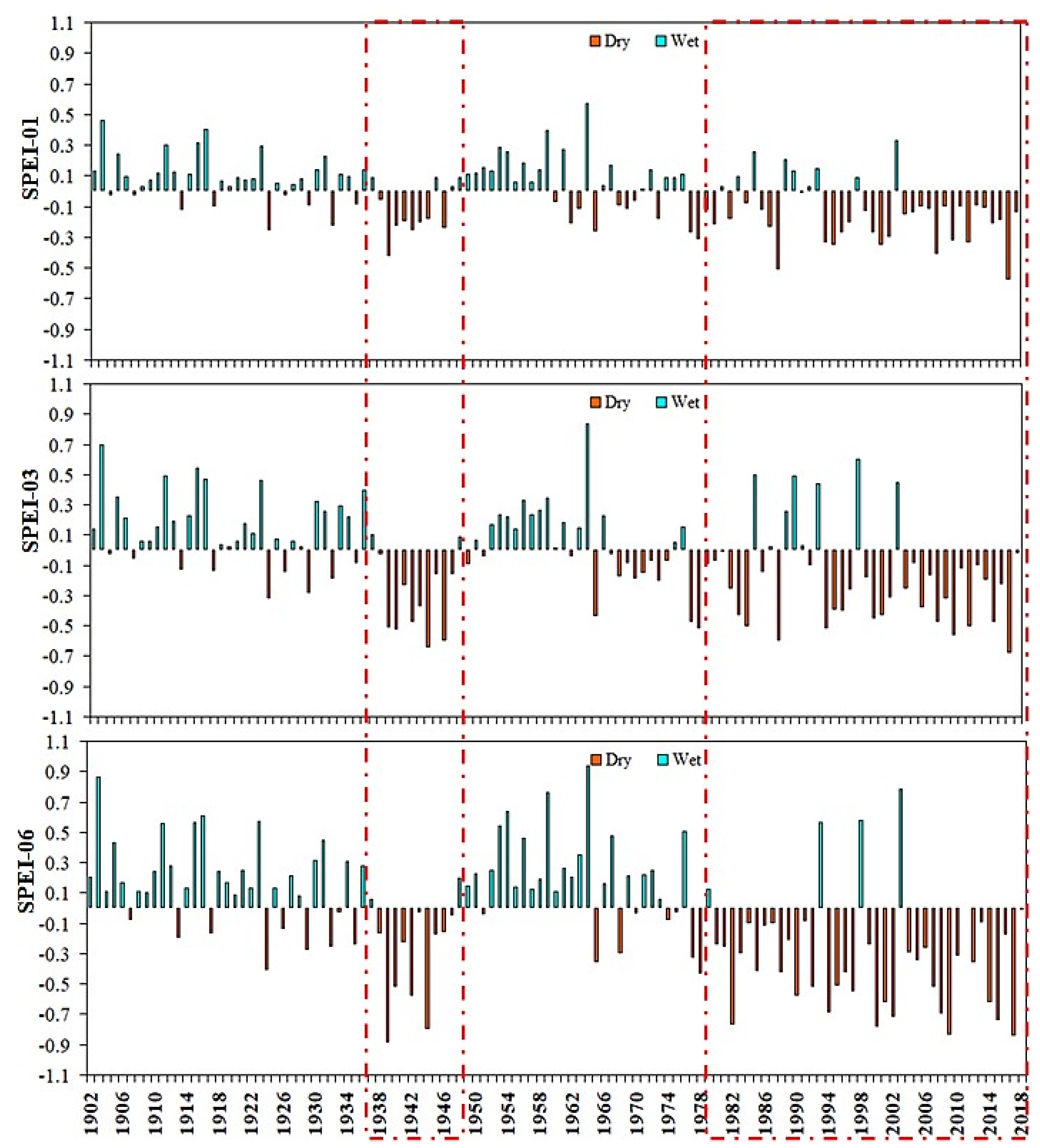

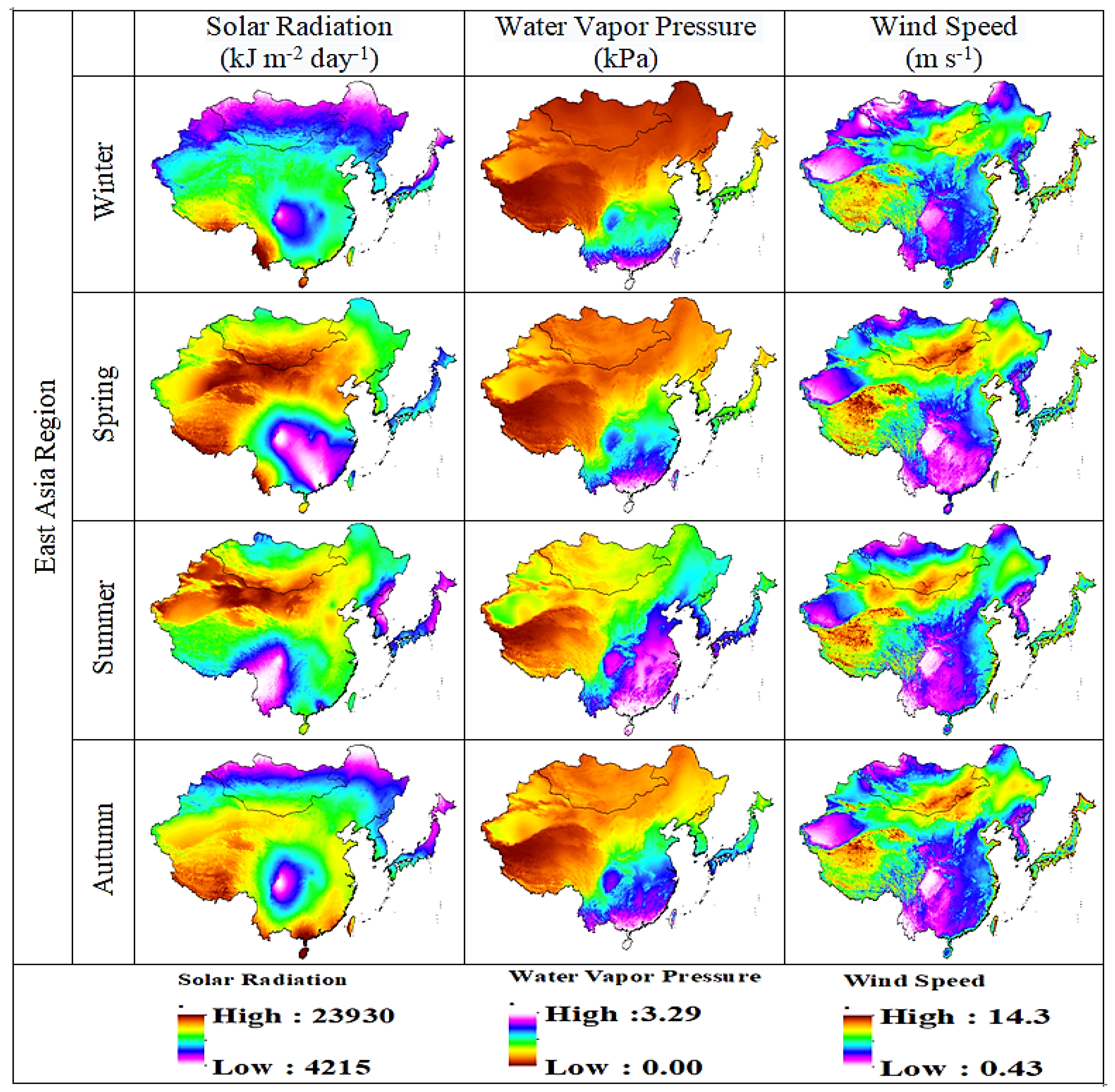




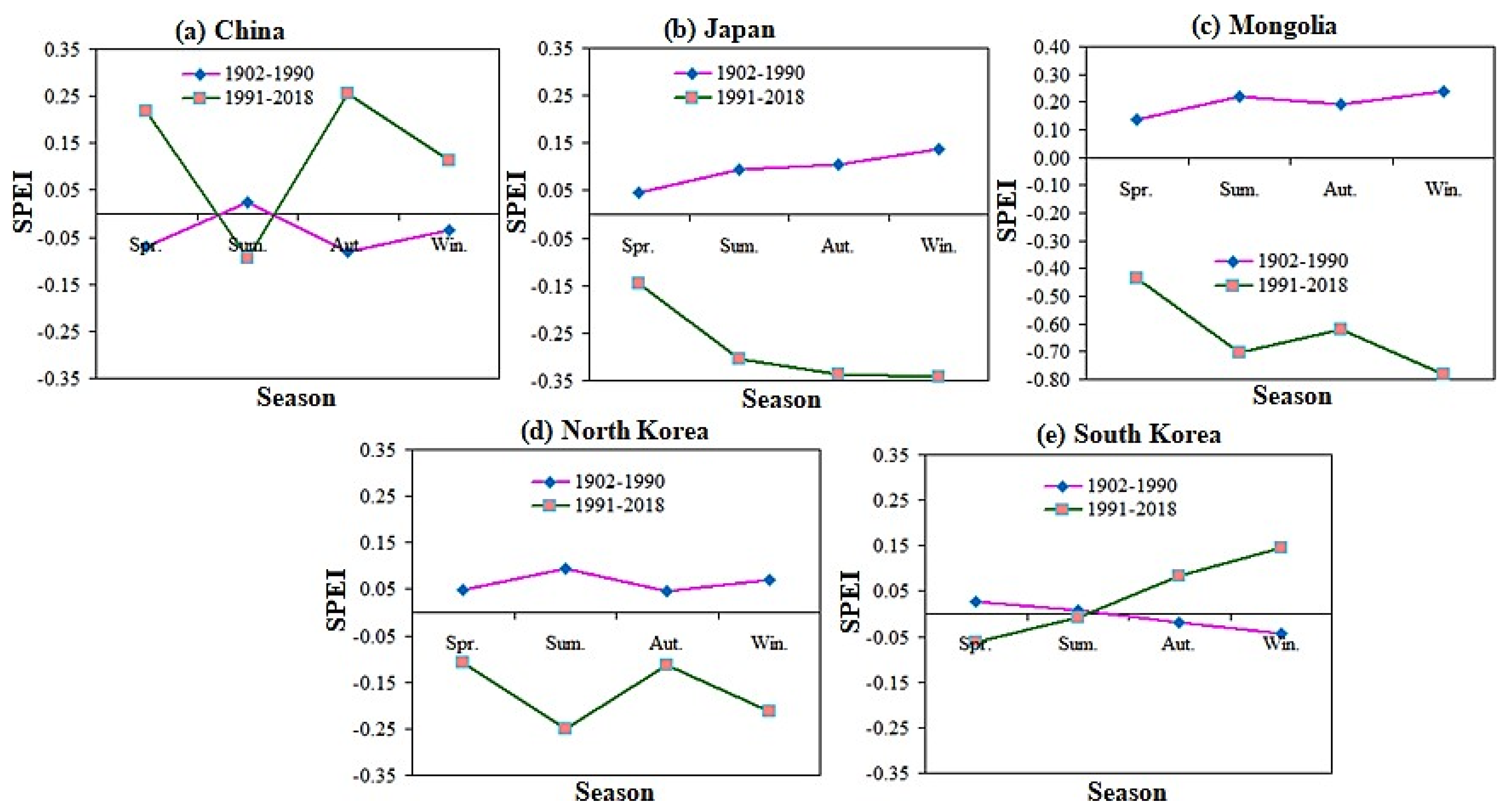
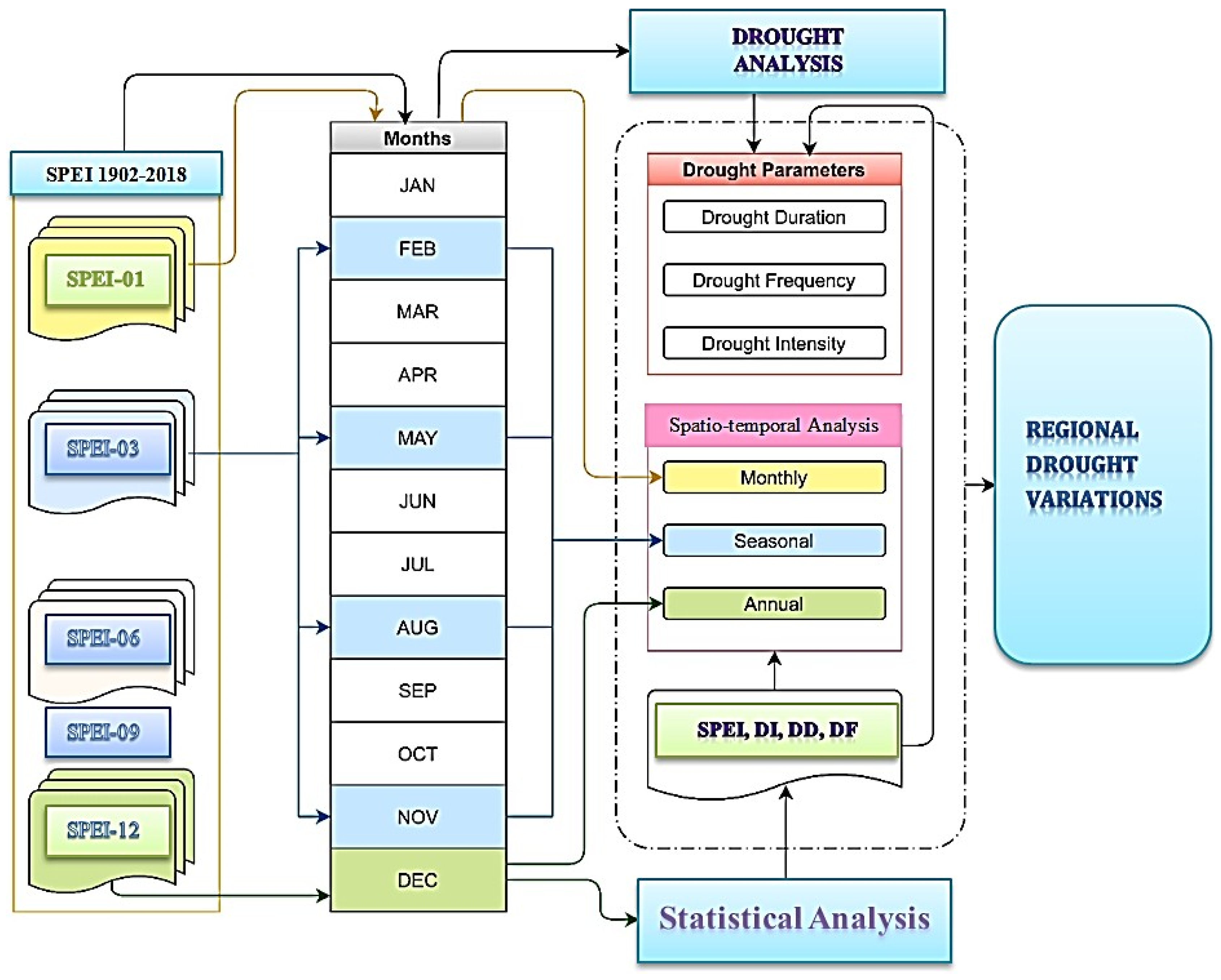
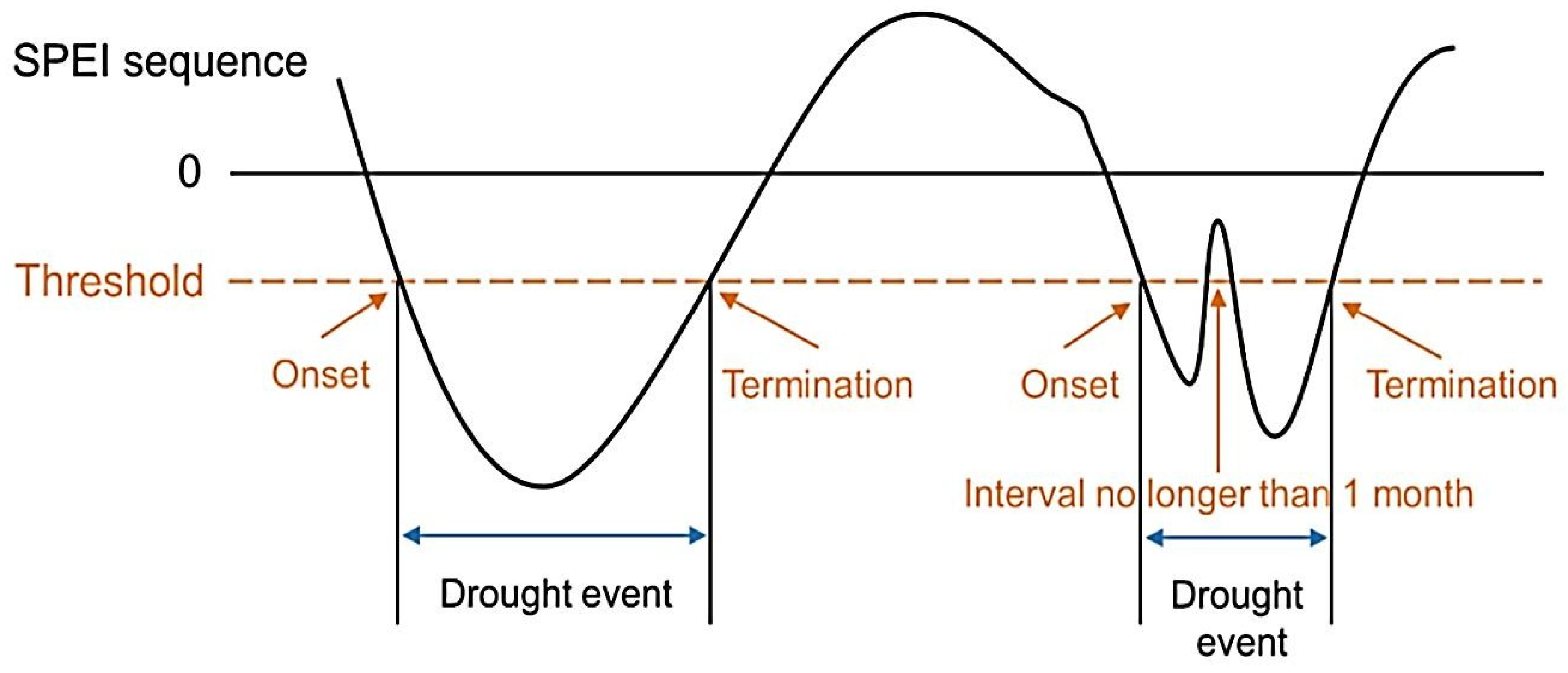

| East Asia Region | Drought Frequency (%) | |||||||||||
|---|---|---|---|---|---|---|---|---|---|---|---|---|
| 1902–1990 | 1991–2018 | 1902–2018 | ||||||||||
| Winter | Spring | Summer | Autumn | Winter | Spring | Summer | Autumn | Winter | Spring | Summer | Autumn | |
| China | 51.8 | 59.0 | 57.7 | 56.3 | 58.6 | 47.6 | 56.5 | 55.4 | 53.4 | 56.3 | 57.4 | 56.1 |
| Japan | 50.7 | 54.7 | 55.1 | 56.4 | 48.2 | 40.2 | 39.3 | 37.8 | 50.1 | 51.2 | 51.4 | 51.9 |
| Mongolia | 59.3 | 62.9 | 64.3 | 64.9 | 30.1 | 22.3 | 23.8 | 17.3 | 52.3 | 53.2 | 54.6 | 53.5 |
| North Korea | 51.1 | 53.3 | 52.2 | 51.2 | 45.2 | 40.5 | 47.9 | 44.0 | 49.7 | 50.2 | 51.1 | 49.4 |
| South Korea | 50.8 | 52.0 | 51.1 | 50.4 | 47.9 | 47.0 | 53.6 | 52.4 | 50.1 | 50.8 | 51.7 | 50.9 |
| East Asia Region | Drought Duration (Month) | |||||||||||
|---|---|---|---|---|---|---|---|---|---|---|---|---|
| 1902–1990 | 1991–2018 | 1902–2018 | ||||||||||
| Winter | Spring | Summer | Autumn | Winter | Spring | Summer | Autumn | Winter | Spring | Summer | Autumn | |
| China | 2.07 | 2.44 | 2.36 | 2.29 | 2.42 | 1.91 | 2.30 | 2.24 | 2.15 | 2.29 | 2.35 | 2.28 |
| Japan | 2.03 | 2.21 | 2.23 | 2.29 | 1.93 | 1.67 | 1.65 | 1.61 | 2.01 | 2.05 | 2.06 | 2.08 |
| Mongolia | 2.46 | 2.70 | 2.80 | 2.85 | 1.43 | 1.29 | 1.31 | 1.21 | 2.10 | 2.14 | 2.20 | 2.15 |
| North Korea | 2.05 | 2.14 | 2.09 | 2.05 | 1.83 | 1.68 | 1.92 | 1.79 | 1.99 | 2.01 | 2.05 | 1.98 |
| South Korea | 2.03 | 2.08 | 2.05 | 2.02 | 1.92 | 1.89 | 2.15 | 2.10 | 2.00 | 2.03 | 2.07 | 2.03 |
| East Asia Region | Drought Intensity | |||||||||||
|---|---|---|---|---|---|---|---|---|---|---|---|---|
| 1902–1990 | 1991–2018 | 1902–2018 | ||||||||||
| Winter | Spring | Summer | Autumn | Winter | Spring | Summer | Autumn | Winter | Spring | Summer | Autumn | |
| China | 0.48 | 0.41 | 0.42 | 0.44 | 0.41 | 0.52 | 0.43 | 0.45 | 0.47 | 0.44 | 0.43 | 0.44 |
| Japan | 0.49 | 0.45 | 0.45 | 0.44 | 0.52 | 0.60 | 0.61 | 0.62 | 0.50 | 0.49 | 0.49 | 0.48 |
| Mongolia | 0.41 | 0.37 | 0.36 | 0.35 | 0.70 | 0.78 | 0.76 | 0.83 | 0.48 | 0.47 | 0.45 | 0.47 |
| North Korea | 0.49 | 0.47 | 0.48 | 0.49 | 0.55 | 0.60 | 0.52 | 0.56 | 0.50 | 0.50 | 0.49 | 0.51 |
| South Korea | 0.49 | 0.48 | 0.49 | 0.50 | 0.52 | 0.53 | 0.46 | 0.48 | 0.50 | 0.49 | 0.48 | 0.49 |
| Grade | Classification | SPEI Values |
|---|---|---|
| 1 | Extremely wet | ≥SPEI 2.0 |
| 2 | Severely wet | 1.5 > SPEI ≥ 2.0 |
| 3 | Moderately wet | 1.0 > SPEI ≥ 1.5 |
| 4 | Slight wet | 0.5 > SPEI ≥ 1.0 |
| 5 | Normal | −0.5 < SPEI ≥ 0.5 |
| 6 | Mild drought | −1.0 < SPEI ≤ −0.5 |
| 7 | Moderate drought | −1.5 < SPEI ≤ −1.0 |
| 8 | Severely dry | −2.0 < SPEI ≤ −1.5 |
| 9 | Extremely dry | SPEI ≤ −2.00 |
| Drought Indices Values | Drought Conditions |
|---|---|
| <0.20 | Extreme drought |
| 0.20–0.30 | Severe drought |
| 0.30–0.50 | Moderate drought |
| 0.50–0.60 | Normal drought |
| >0.60 | No drought |
Disclaimer/Publisher’s Note: The statements, opinions and data contained in all publications are solely those of the individual author(s) and contributor(s) and not of MDPI and/or the editor(s). MDPI and/or the editor(s) disclaim responsibility for any injury to people or property resulting from any ideas, methods, instructions or products referred to in the content. |
© 2024 by the authors. Licensee MDPI, Basel, Switzerland. This article is an open access article distributed under the terms and conditions of the Creative Commons Attribution (CC BY) license (https://creativecommons.org/licenses/by/4.0/).
Share and Cite
Ali, S.; Basit, A.; Umair, M.; Makanda, T.A.; Shaik, M.R.; Ibrahim, M.; Ni, J. The Role of Climate Change and Its Sensitivity on Long-Term Standardized Precipitation Evapotranspiration Index, Vegetation and Drought Changing Trends over East Asia. Plants 2024, 13, 399. https://doi.org/10.3390/plants13030399
Ali S, Basit A, Umair M, Makanda TA, Shaik MR, Ibrahim M, Ni J. The Role of Climate Change and Its Sensitivity on Long-Term Standardized Precipitation Evapotranspiration Index, Vegetation and Drought Changing Trends over East Asia. Plants. 2024; 13(3):399. https://doi.org/10.3390/plants13030399
Chicago/Turabian StyleAli, Shahzad, Abdul Basit, Muhammad Umair, Tyan Alice Makanda, Mohammed Rafi Shaik, Mohammad Ibrahim, and Jian Ni. 2024. "The Role of Climate Change and Its Sensitivity on Long-Term Standardized Precipitation Evapotranspiration Index, Vegetation and Drought Changing Trends over East Asia" Plants 13, no. 3: 399. https://doi.org/10.3390/plants13030399






